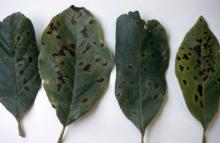Cause Pseudomonas syringae pv. mori, a bacterium favored by cool, wet weather in spring. The OSU Plant Clinic has diagnosed this disease several times. Young leaves are more susceptible to infection. Bacteria appear to gain entry into the leaf by colonizing and destroying epidermal idioblasts (specialized leaf cells). Young idioblasts of mulberry do not have calcium deposits while older leaves have these concretions (cystoliths).
Symptoms Leaf spots are small and brown-black, usually with yellow haloes. Infected leaves are often distorted. Infected buds may become disfigured as they swell. Young shoots may show rapid necrosis and dieback. Occasional stem cankers occur, which may exude ooze. Infected bushes and trees often appear stunted.
Cultural control
- Minimize wounds to limbs and new shoots.
- Prune out and destroy infected shoots and branches during the late dormant season.
- Space plantings to provide good air circulation.
Chemical control The following are registered on weeping mulberry; do not use on edible types.
- Badge X2 at 1.5 to 2 lb/A. Group M1 fungicide. 48-hr reentry. O
- CuPRO 5000 at 1.5 to 5 lb/A but only up to 2 lb/A when new growth is present. Group M1 fungicide. 48-hr reentry.
- Junction at 1.5 to 3.5 lb/A. Group M1 + M3 fungicide. 48-hr reentry.
- Monterey Liqui-Cop at 3 Tbsp/gal water. H
- Nu-Cop 50 DF at 1 lb/100 gal water. Group M1 fungicide. 48-hr reentry.
References Gupta, V.P., Tewari, S.K., and Datta, R.K. 1995. Surface ultrastructural studies on ingress and establishment of Pseudomonas syringae pv. mori on mulberry leaves. Journal of Phytopathology 143:415-418.
Sugimura, Y., Mori, T., Nitta, I., Kotani, E., Furusawa, T., Tatsimi, M., Kusakari, S., Wada, M. and Morita, Y. 1999. Calcium deposition in idioblasts of mulberry leaves. Annals of Botany 83:543-550.


